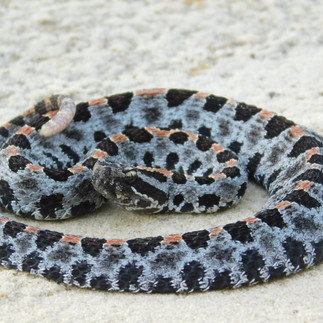Research Update: Artificial Refugia (Winter 2025)
- ajarboe
- Apr 24
- 4 min read
At TRC, our mission is to advance the protection of rattlesnakes and their habitats through research and education. Our programs seek to bring on-the-ground benefits to rattlesnakes - or in the case of our Artificial Refugia project in the ground (pun intended). Artificial Refugia are manmade structures meant to provide overwintering microhabitat and possible protection from other environmental conditions (such as summer highs or fires). We're building them on lands which were historically mismanaged (i.e. livestock grazing, logging plantations, fire suppression), and as a result lack the density of natural refugia that a more natural or well-managed habitat might. In theory, these structures can provide shelter for rattlesnakes and other species until the point at which natural refugia (such as tortoise burrows or fire-hollowed stump holes) repopulate the landscape.
Now this brings us to the Winter of 2025. If you're following along with us from Florida, or anywhere in the Southeast, you are probably aware of the crazy winter storms that hit the area this winter. Snow in the panhandle, freezes through the peninsula, and even sleet at our office in Jacksonville! Well, these drops in temperature could have spelled good news or bad news: the good news being that despite our subtropical climate, my artificial refugia were truly put to the test in the face of freezing temperatures. The bad news: that I had no way of knowing if they'd pass that test. On a mild February morning I set out to one of my research sites - hereby dubbed "Site Loblolly" due to the row-planted silviculture pines that dominate the landscape - to get an idea of how these labors-of-love built with sweat, blood and blisters had held out against the worst of the January Jetstream's freeze. Needless to say, the forest on that February morning rang out with the sounds of me shouting success!

Above is a rough graph of the temperatures recorded between the time I put the data loggers into the refugia and the time I checked them. Note that the minimum recorded temperature - that is the absolute coldest it got - was 11.2 Celsius. That's about 52 Fahrenheit!
Quite warm if you're a reptile in a freezing winter storm, right? Well, that's just the minimum - the absolute lowest temperature it dropped to. Both the average and the median temperature inside the refugia both came to around 16 Celsius, or around 60 Fahrenheit. That's only a few degrees a below some of the averages reported for Gopher Tortoise (Gopherus polyphemus) burrows!
By the end of the month, I was able to verify that the internal temperatures seen at the first refugia at Site Loblolly were not abnormal, but rather a consistent feature of our design. At Site Bahia - a former livestock pasture dominated by non-native turfgrass - I was able to collect internal and external data for two semi-adjacent refugia. What I found was that the internal temperatures held stable, and both refugia seemed to "mimic" the trend of one another.

Above is a graph showing the internal (green & black) versus external (red & warm grey). What I mean by "mimic" is that the temps recorded inside each chamber didn't vary much from one another, while the temps on the outside varied wildly based upon conditions (sun exposure, wind, etc.). Why this is good news is because it demonstrates relative internal stability, and stability means snakes (and other species) will be able to rest there without risking sudden temperature swings.
With Winter drawing to a close and the Spring Emergence season arriving, I ventured out to one of our last sites - Live Oak, a former sandhill which had since become overgrown and shaded out by encroaching hardwoods (including the namesake evergreen oak). In terms of temperature data, Live Oak added to the trend - but if you're reading it and this far in you probably want something more than just temperature points on a boring graph line...
You probably want a snake.
Well, the unassuming bump in the ground hidden on the side of debris-strewn hill that was Site Live Oak ended up being the refugia that gave us our first overnight snake!

For those of you familiar with the blotchy backside and spade-shaped head pattern, you probably recognize this as Pygmy Rattlesnake (Sistrurus miliarius)! If not, well it is a blurry photo and it took me a sec to realize what kind of snake I was looking at. It's a small victory, but how cool is it that our first resident was a Rattlesnake?
I know, I know! I promised you a picture of a snake then gave you a blurry black-and-white camera photo of a Pygmy slithering into a pipe. So, here's my photo tax: A trio of Pygmy Rattlesnakes found during either other research projects and one during our Level 2R: Introduction to Field and Research Techniques! If you look close enough, you can trace the back and head pattern to the snake seen on camera above.
Between starting and finishing this blog post, we've already got some neat Spring emergence season updates for you, so be sure to follow us on social media and check back to our blog page in the coming weeks! As always, if you like the work that we do please consider becoming a sustaining member! Support from our members ensures that programs such as this can continue and expand!




.png)





